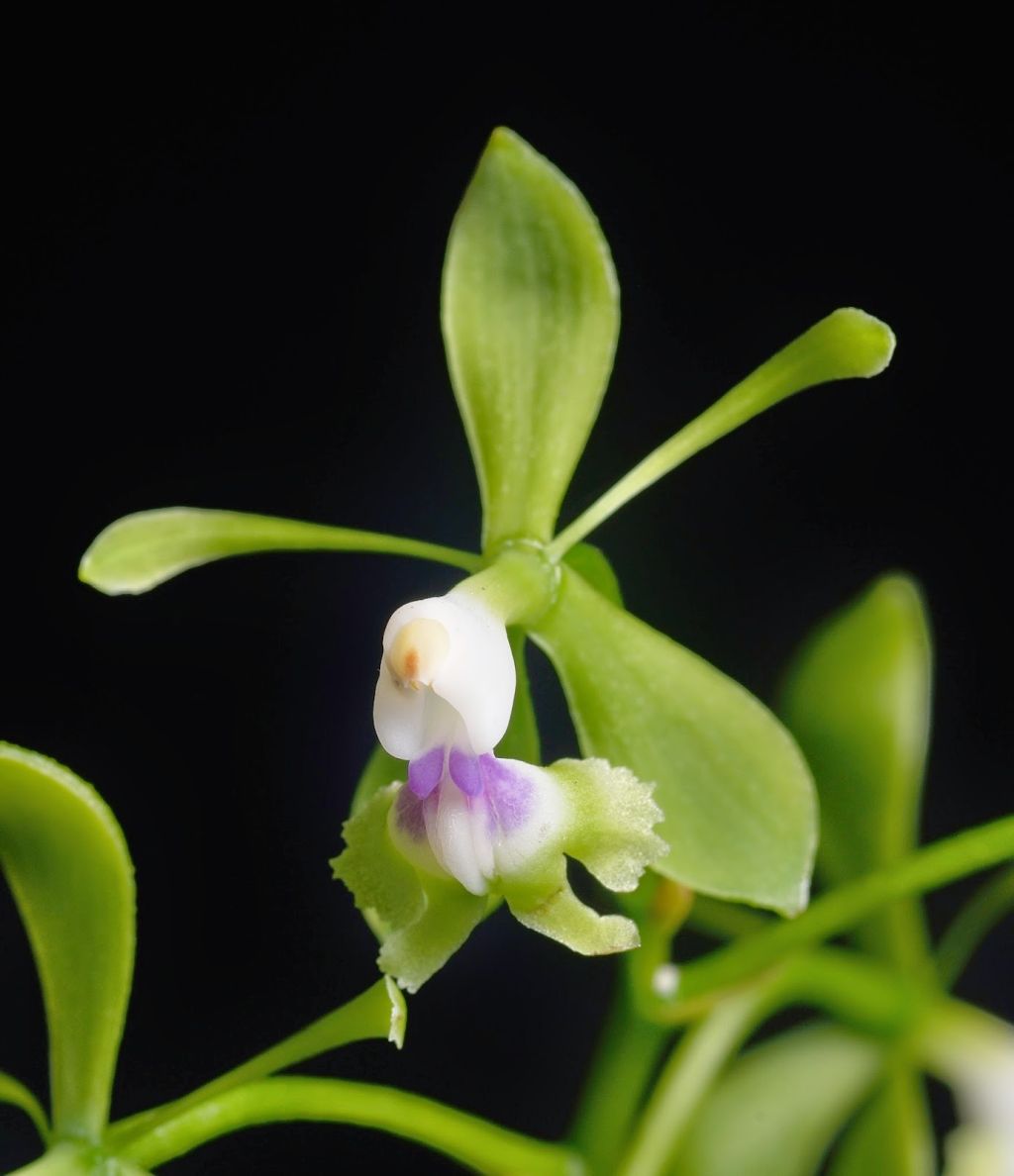

Epidendrum unguiculatum (C.Schweinf.) Garay & Dunst. 1976 GROUP Pseudepidendrum SUBGROUP Pluriracemosum
Photo by © SITF © AND AOS Website
Drawing by © Jimenez, Hágsater & E.Santiago and The AMO Herbario Website



Common Name The Clawed Epidendrum
Flower Size 1.2" [3 cm]
Found in Venezuela, Guyana, French Guiana, Surinam, Brazil and Peru in wet montane forests at elevations of 100 to 300 meters as a medium sized, hot growing epiphyte with simple, cane-like, terete, straight stems enveloped completely by several, imbricate, scarious bracts and carrying 8, distichous, articulate, unequal in size, basally much smaller, green above ventral surface occasionally purple, elliptic to oblong-elliptic, acute, margin entire leaves that blooms in the spring on a terminal, erect, pluri-racemose, successive racemes deveop from the distal bracts of the peduncle, peduncle to 8.8" [22 cm] long, with up to 4, large, tubular, acute, conduplicate bracts, paniculate, to 22" [50 cm] long overall, successively 6 to 8, 16 to 25 many flowered inflorescence with each branch carrying several, spreading flowers with much shorter than the ovary, triangular-lanceolate, acuminate, amplexicaul floral bracts and carrying resupinate, non-fragrant flowers.
"Epidendrum unguiculatum belongs to the GROUP Pseudepidendrum which is characterized by caespitose plants, cane-like stems, acute to acuminate leaves usually apical inflorescence, the mostly filiform petals and the lip usually 3-lobed with 3 parallel fleshy keels, the apical lobe often bifurcate, the “bird-wing” type pollinia, at least the inner pair, and SUBGROUP Pluriracemosum which has a racemose and few-flowered inflorescence on an elongate peduncle, usually producing new racemes over the years and thus pluri-racemose, the rachis is elongate, and thus lax flowered, the flowers are bicolored, basically green to brown with the lip white to purple, spotted or not. The species is recognized by the lax, few-flowered pluri-racemose inflorescence, the large flowers with the apex of the sepals dorsally papillose .72 to .8" [18 to 20 mm] long, green with the apex of the column and disc of the lip white, the calli frequently tinged purple, especially in the northern populations. It is very similar florally to Epidendrum isthmii Schltr. which ranges along the Atlantic lowlands of Mesoamerica, but that species has a paniculate, simultaneous inflorescence, somewhat smaller flowers, sepals dorsally glabrous, .52 to .6" [13 to 15 mm] long, the calli never tinged purple. Epidendrum pluriracemosum Hágsater & E.Santiago produces pluri-racemose inflorescences with a zigzag rachis, flowers open usually 2 open at one time, smaller, sepals .36 to .42" [9 to 10.5 mm] long, petals linear-filiform, and the mid-lobe of the lip is separated by a very short isthmus, the lip is always immaculate white. Epidendrum huamantupanorum Hágsater & E.Santiago has intermediate sized plants, about 20" [50 cm] tall, narrowly elliptic and short acuminate leaves, the greenish copper sepals .6" [15 mm] long and petals, column base greenish, apical half lavender, the lip hyaline white, the calli and ribs lavender, surrounded by a darker ring, the convex lip with the lateral lobes hemi-elliptic. Epidendrum oenochrochilum Hágsater, Ric.Fernández & E.Santiago has elliptic, acute leaves 1.12 to 2.6" x .4 to 1" [2.8 to 6.5 x 1 to 2.5 cm], purple-brown colored flowers with the lip yellow-brown or dirty pink, the lateral lobes of the lip sub-quadrate. Epidendrum maroniense Hágsater & E.Santiago has somewhat smaller flowers, lateral sepals .664 to .68" [16.6 to 17 mm] long, linear-filiform petals and the lip is transversely rectangular in outline, the base truncate." Hagsater etal 2013
Synonyms *Epidendrum paniculatum var. unguiculatum C.Schweinf. 1943
References W3 Tropicos, Kew Monocot list , IPNI ; Orchids of Peru Vol 2 Fieldiana Schweinfurth 1959 as E paniculatum var unguiculatum; Venezuelan Orchids Vol 2 Dunsterville & Garay 1961 as E fastigiatum drawing fide; Venezuelan Orchids Illustrated Vol 6 Dunsterville & Garay 1976 drawing fide; Orchids of Venezuela, An Illustrated Field Guide Vol 1 Dunsterville & Garay 1979 drawing fide; The Orchids of Surinam Werkhoven 1986 photo fide; Icones Orchidacearum Peruviarum plate 474 Bennetii & Christenson 1998 drawing fide; Orchids of Venezuela [An illustrated field guide] Vol. 1 Ramiro and Carnevali 2000 drawing fide; Orquideas Nativas del Tachira Cesar Fernandez 2003 photo fide; Flora of the Venezuelan Guayana Vol 7 Steyermark, Berry, Yatskievych and Holst 2003; Orquideas de Roirama Luz & Franco 2012 photo good; Orchids of French Guiana Szlachetko, Veyret, etal 2012 drawing/photo fide; Icones Orchidacearum 14 Plate 1455 Hagsater & Sanchez 2013 see recognition section; Icones Orchidacearum 14 Plate 1476 Hagsater & Sanchez 2013 see recognition section; Icones Orchidacearum 14 Plate 1484 Hagsater & Sanchez 2013 see recognition section; Icones Orchidacearum 14 Plate 1492 Hagsater & Sanchez 2013 drawing/photo fide; AOS Bulletin Vol 85 #11 2016 photo fide; Orquideas, Tesoro de Colombia Vol 2 Ortiz & Uribe 2017 drawing/photo ok; Icones Orchidacearum 16[1] Plate 1630 Hagsater & Santiago 2018 See recognition section;
--------------------------------------------------------------------------------------------------------------------------